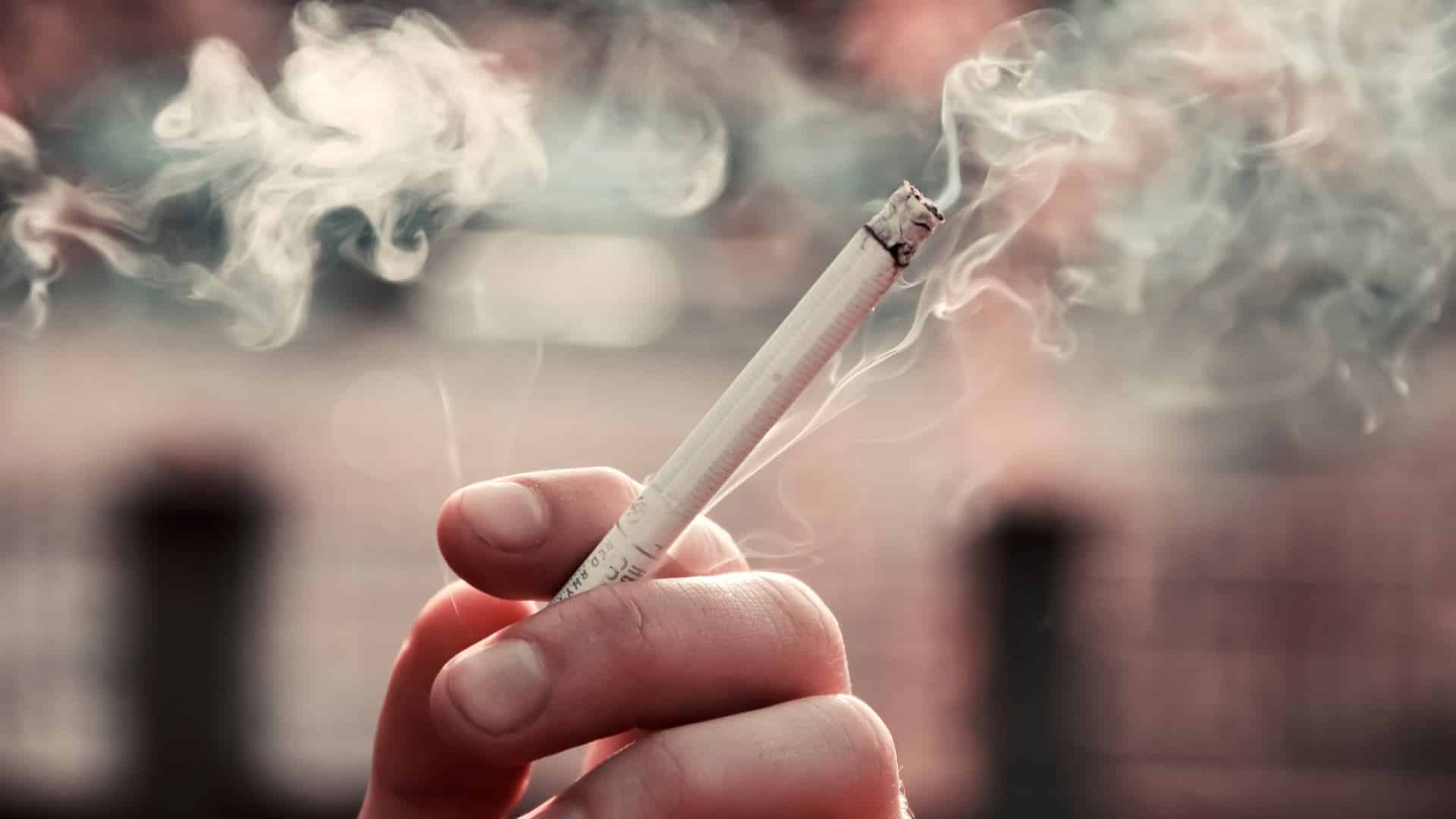Globally, rates of smoking are in decline. But in Indonesia, a cigarette is a measure of masculinity and hospitality. That makes it habit hard to break.

A hand holds a lit cigarette. (Credit: Geri Tech, Pexels)
To see blue fire that flames up as high as five meters inside a volcanic crater, I trekked with a group of tourists on an overnight expedition to the Kawah Ijen National Park on the island of Java in Indonesia.
Kawah Ijen is known for its yellow sulphur deposits which produce the iconic blue fire flames. They can only be seen in the dark.
It was the only light we could see, aside from a glow from the cigarette held by my chain smoking guide.
In my 10 days in the country, I saw the same scene countless times: men chain-smoking beside their families, in markets, on buses, sometimes even while holding their children.
“My father was a smoker,” said the guide, whose name I’m withholding to protect his identity. “Even as a toddler, I remember him holding me in one hand while holding a cigarette in the other.”
Globally, tobacco use remains a major public health challenge, though patterns vary widely.
The undisputed danger of smoking
Still holding a cigarette, my guide to the crater told how his wife recently miscarried twins. I stopped to ask if he smoked inside his house, and he replied yes.
A 2019 study showed exposure to cigarette smoke (also known as passive or second-hand smoking) was responsible for 14% of population attributable stillbirths in Indonesia. This means that 14% of stillbirths in Indonesia can be linked to this one risk factor.
According to a 2024 report from the World Health Organiztion, about 25% of people aged 15 or over in the European region smoke cigarettes. In Southeast Asia, a little over 26% of people use tobacco. There is a big gender gap in that number: It accounts for half of all males but only 14% of females.
Smoking remains the dominant form of tobacco use worldwide. Nearly 90% of smokers rely on cigarettes, which are linked to cancer, cardiovascular disease, respiratory illness and a significant burden of preventable deaths each year.
Indonesia, however, stands out even within the Southeast Asian region. With nearly 70% of adult men smoking — the highest percentage in the world — the country not only defies regional trends but also highlights a deeply entrenched cultural acceptance of cigarettes.
Unlike in many countries where smoking is increasingly seen as socially undesirable, in Indonesia it remains intertwined with masculinity, social etiquette and hospitality, making the epidemic as much a cultural challenge as a public health one.
The economic costs of tobacco addiction
The costs of this cultural acceptance are staggering. Smoking in Indonesia has been well established as a public health concern for the country. Smoking-related illness is reported to be as high as 93% in hospitalised Indonesian men according to a 2015 study.
A 2022 study showed that, in the year 2019, the economic cost of smoking-related illness — the costs of healthcare and lost productivity — was almost 1.5-2.5% of the gross domestic product of Indonesia. That’s the data point used to measure the economic health of a country.
Passive smoking, however, also significantly plays a role in these figures, with nearly half of the recorded cancer cases in the country resulting from passive smoking.
In recent years, Indonesia has tried to reduce the number of smokers by adopting measures now common in many Western nations including increasing the age of purchase of cigarettes from 17 to 21 in 2024, banning the sale of cigarettes around educational institutions and increasing taxation on cigarettes.
However, a walk through Indonesian streets reveals that many teenagers under 21 have easy access to cigarettes even after the legal reform. The introduction of e-cigarettes has also increased smoking in Indonesian youth.
Curbing a collective habit
The reason for the failure of Indonesia to curb smoking is that Indonesian policy deals with cigarettes as a product, while the people view cigarettes as a cultural symbol.
A study about the beliefs and norms associated with smoking in Indonesian teenagers revealed that many teenage boys believed that they were “Not a real man” if they did not smoke. There is also an ostracization of non-smokers as effeminate men in Indonesia.
In some ways this mirrors the marketing of cigarettes in the United States for about 50 years. The iconic Marlboro Man, an image of a rugged cowboy that advertised Marlboro cigarettes, wasn’t retired until 1999.
Furthermore, smoking has also found a way into becoming a part of good social etiquette in Indonesia. In local community and family events, hosts serve cigarettes to the attendees as a form of respect. This leads to about 70% of Indonesian homes being the sites of second-hand smoke exposure to non-smoking women and children.
Behavioural studies also show that Indonesian men use cigarettes as a status symbol — smoking expensive cigarettes shows that they are financially well-off.
The effect on a family’s economic health
According to several studies, this acceptance of smoking as a household essential expenditure also competes directly with money spent on nutrition and other basic needs.
This shows that smoking has an impoverishing effect on Indonesian households. And even after recent price increases, Indonesian cigarettes are still cheaper than in most lower and middle-income countries. At least one study has found that raising the price of cigarettes could serve to worsen poverty rather than spur smokers to quit.
In contrast to the guide who took us to see the blue flames, Wisnu, a driver who took us to see some Balinese temples, said he has never smoked. Neither his father nor grandfather smoked and that’s the reason, he said, that he never lit up a cigarette in his life.
“There needs to be a cultural overhaul in the acceptance of smoking as a tolerable habit,” Wisnu said. “Every single person I have met that doesn’t smoke, I have noticed that the common factor they have is a parent that didn’t smoke as well.”
Studies back up Wisnu’s theory. Young men who came from families with fathers who smoked or from families where smoking was accepted and tolerated went on to become smokers themselves.
Warning labels are not enough.
To break this intergenerational hold of smoking on Indonesian men, public health efforts must go beyond warning labels and taxation. They must reshape the cultural meaning of smoking itself.
This means creating a counter-narrative where cigarettes are no longer seen as symbols of camaraderie or manhood, but as markers of exploitation by the tobacco industry and threats to family wellbeing. Religion offers a compelling entry point for this cultural shift.
Indonesia is the world’s largest Muslim-majority country, and its citizens often place high trust in religious authorities. If Islamic leaders across the country were mobilised to speak with one voice, linking tobacco use to neglect of one’s duty to protect life and health, this could create a strong moral imperative to quit.
Public campaigns could pair this religious framing with stories of families harmed by smoking, making the message emotionally resonant as well as doctrinally sound.
Public campaigns must also elevate male role models — sports stars, musicians, politicians — who proudly reject smoking, reframing masculinity in terms other than lighting up a cigarette. Popular media, including films, television and social media influencers, should depict non-smoking as aspirational and smoking as outdated or socially irresponsible.
Where schools come in
Furthermore, school-based education should portray tobacco companies as predatory businesses targeting the poor and youth, thereby reframing smoking as an act of corporate manipulation rather than free choice.
Several countries have done this in the past. Thailand enacted the Non-Smokers’ Health Protection Act in 1992, which declared that non-smokers have a protected right to clean air. This led to designated venues for smoking while protecting non-smoking areas. In Malaysia, in 1995, the National Fatwa Council declared smoking to be “haram” (forbidden) in Islam due to its harmful health effects.
This religious edict has influenced public perception of smoking as a negative habit. South Korea has shown declining smoking rates, especially among men, over the years. And studies done in South Korea reveal that currently there is stigmatisation of smoking in the public consciousness of the country. Such a perception leads to more people attempting to quit.
These examples show that there are ways in which Indonesia can adapt to make smoking undesirable for its people.
Positive masculinity can be embraced by reframing men as protectors and providers who would never compromise their family’s health or diminish household nutrition by spending on cigarettes. In that scenario, smoking shifts from a symbol of manhood to a betrayal of it.
This approach links masculinity to safeguarding children’s lungs, ensuring food on the table and embodying responsibility — turning smoke-free living into a proud badge of honour.
QUESTIONS TO CONSIDER
1. Why does smoking seem to be so pervasive in Indonesia when the rest of the world is kicking the habit?
2. How do you get people to change behaviour that that is culturally acceptable?
3. If you were a health minister of your country what policies or laws regarding cigarettes would you impose if able?

Dr. Christianez Ratna Kiruba is an internal medicine physician from India who is a patient rights advocate and is passionate about analysing public health issues through a gender lens. She is a graduate of the University of Toronto’s Dalla Lana Fellowship in Journalism and Health Impact.
